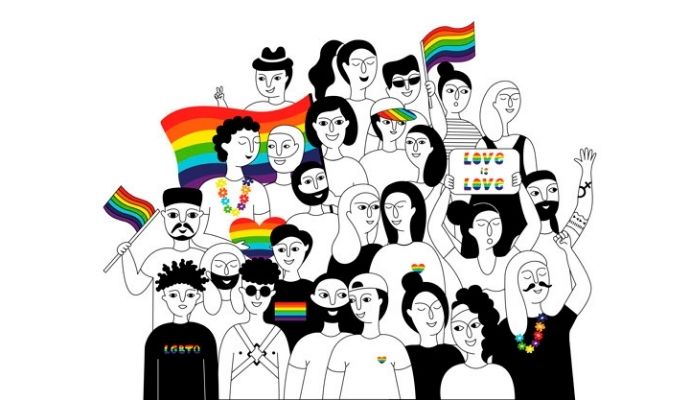Quick ‘Dos and Don’ts’ Guide To Help Your Company Do More For The LGBTQ+ Community

Written by: Elisha Vermani
It’s that time of the year again when advertising folks are under immense pressure to come up with an original campaign for Pride Month that preferably goes beyond rainbows and sparkles. But why the month of June specifically?
Pride Month honours years of struggle for equal rights and the unending quest for legal justice, liberty and dignity for the lesbian, gay, bisexual, transgender and queer community. But the event that became a turning point in this relentless struggle were the Stonewall Inn riots in New York that occurred in the month of June in 1969.
The first Pride march then took place in 1970, a year later, to commemorate those who fought for their rights during the riots. However, what began as a political movement for acceptance and normalisation of the LGBTQ+ community has overtime been dissociated from its roots in activism to be commodified by corporates often under the guise of gesturing support for them.
At first it seems great that companies are directing their advertising and marketing efforts to raise awareness for a social cause: McDonald’s launched rainbow french fry containers in its stores in the United States last year, Adidas launches a “Pride Pack” collection every June, and Nike has a special pride themed collection called “BeTrue” to name a few. But something is amiss.
The Problem
When portions of Section 377 of the Indian Penal Code were struck down in 2018, the queer community across the country celebrated the verdict and brands like Zomato, Ola and Uber were quick to hop onto the bandwagon by including rainbow colours in their logo, social media posts and even their products. While it may have been done to celebrate along with the queer community, the timing to position themselves as allies raises a few questions.
“I’m glad that these companies are standing in solidarity but why suddenly now? A majority of the brands turned their logos into rainbows, and it doesn’t harm the community but if we look at the bigger picture, these companies have never stood up for the LGBTQ rights until today and majority of these companies do not hire transgender people, nor do they have a policy for it,” said professional drag queen and activist, Jabez Kelly, in an interview with the New Indian Express.
While it’s true that pride campaigns sometimes manage to nudge the door in spaces that aren’t welcoming or simply ignorant of the LGBTQ community, it’s also undeniable that a lot of these promotional efforts provide mere lip service to the community without fostering a tangible change that they would actually benefit from and there’s a term for it — rainbow capitalism.
Simply put, it refers to a brand or an organisation attempting to profit off of the queer community by appropriating the cause for private gain. The same companies that put out these elaborate campaigns to extend support to the LGBTQ+ also end up contradicting themselves either by having exclusionary hiring policies, unsupportive work cultures or by investing in organisations that are anti-LGBTQ.
For instance: Adidas, despite the “Pride Pack” collection to celebrate the Pride Month, was one of the biggest sponsors of FIFA 2018 World Cup that was held in Russia — a country with a slew of anti-LGBTQ+ laws while Nike despite all its inclusive campaigns benefits from investing in private prison in the US ignoring the skewed incarceration rate of people belonging to the queer community.
While this may be the case for most corporations trying to profit from Pride, there are a few who are going beyond promotional activities to truly support the community. Parmesh Shahani, director of the Godrej India Culture Lab — an experimental space that produces research and events spanning academia, activism and business — said that the company provides equal opportunity policies to all its employees and does not discriminate on the basis of sexual orientation.
“Our anti-harassment policies are gender neutral. We also have equal benefits to same-sex partners of employees, fully paid three month adoption leave (also gender neutral) and a medical benefit scheme which includes the spouse/domestic partner, parents and/or children of an employee,” he told the Economic Times.
In conversation with Ungender after the launch of his book Queeristan, Shahani talks about what companies can do in the workplace to create conducive environments in which one can model a good, safe and nurturing space. Fortunately, Godrej isn’t alone in taking inclusive measures at the workplace.
Keshav Suri, the executive director of Lalit Suri Hospitality Group, is one of the pioneers of implementing inclusive policies at the workplace and a vocal advocate for the rights of the LGBTQ+ community. Their diversity and inclusion policy includes providing cover for gender reassignment surgeries for trans employees thus underlining the need to go beyond a one-size-fits-all approach towards making workplaces more inclusive.
So here are a few ‘Dos’ and ‘Don’ts’ for companies trying to figure out what to do for Pride Month.
Do: Plan social media campaigns for pride month to be in sync with the marketing calendar.
Don’t: Promote content aimed towards the queer community only during the pride month, the community is very much present during the other 11 months too.
Do: Give creators from the community an opportunity to platform their work via yours.
Don’t: Pay them with “exposure” or expect free content from them.
Do: Find ways to make your product or service more inclusive.
Don’t: Slap a rainbow sticker on it and call it a day.
In case you need help figuring out how to be more inclusive, here’s a good first step to take.
Do: Create special merchandise for the Pride Month.
Don’t: Skimp on donating money that comes from the special merch to NGOs or other organisations that work on alleviating problems faced by the community.
Do: Read and educate yourself to create a more supportive work culture for employees from the community.
Don’t: Skip reading this very helpful guide on hiring LGBTQIA+ workers. For a more in-depth understanding of diversity and inclusion, here’s another guide for you.
Companies that pledge their support to the community all year round and beyond promotional activities stand to benefit from the inclusive environment they create. While this change will not happen overnight, taking steps towards building a workplace that takes diversity and inclusion seriously ultimately helps set an industry standard that could pave the way for societal change.
About the author: Elisha is a student of Multi Media and Mass Communication at Indraprastha College for Women, Delhi University. When not writing, you’ll find her complaining about the news or deconstructing badly made spy films just for laughs.
Ungender Insights is the product of our learning from advisory work at Ungender. Our team specializes in advising workplaces on workplace diversity and inclusion. Write to us at contact@ungender.in to understand how we can partner with your organization to build a more inclusive workplace.
Read our insights about diversity, legal updates and industry knowledge on workplace inclusion at Ungender Insights. Visit our Blog.
Sign up to stay up-to-date with our free e-mail newsletter.
The above insights are a product of our learning from our advisory work at Ungender. Our Team specialises in advising workplaces on gender centric laws.
or email us at contact@ungender.in




